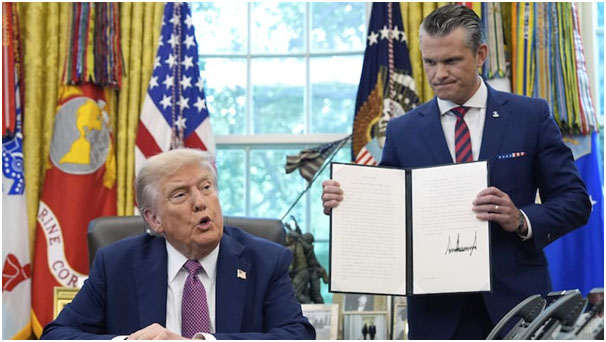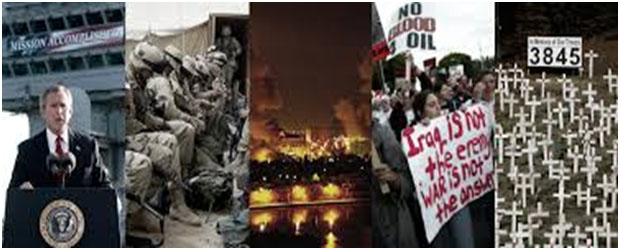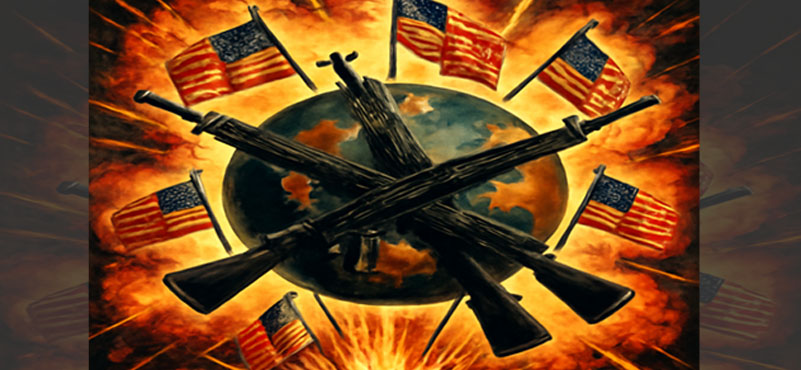United States President Donald Trump, on 5 September, signed an executive order to rename the “Department of Defence” as the “Department of War,” reverting to a title it had held until after World War II. The switch is indicative of American coercion through the traditional unilateralism and exceptionalism openly stamped by aggression.
At first look, it may look semantic, but a deep dive unravels the intent and political consequences in an already conflict-ridden world. To rename is to redefine, and in renaming, Trump has framed America’s global role through a lens that is unvarnished, unapologetic, and deliberately provocative.

Since its independence in 1776, there has hardly been a decade that the nation has experienced a period without war. What started as a fight against the colonialist masters swiftly developed into expansionist actions against the native people, then Latin America, and later the world wars that characterised the twentieth and twenty-first centuries. The sheer continuity of this pattern is no accident. War has become the operating system of America, a constant fuel for its politics, economy, and global dominance.
War as America’s Permanent Companion
Almost every generation of Americans has been marked by war. In the nineteenth century, the U.S. fought Native American tribes to expand its territorial reach, and later clashed with Mexico to seize vast stretches of land. By the end of that century, it had secured overseas colonies from Spain and projected itself as a budding empire.
The twentieth century elevated this into a global habit. Two world wars, countless interventions in Latin America, and the long Cold War with the Soviet Union positioned the United States as the default security provider and the default aggressor across continents. With the Soviet collapse, rather than scaling back, Washington expanded its appetite. Iraq, Afghanistan, Libya, Syria, and now Ukraine are all chapters in the same story.
This permanence of war is not a reflection of an unusually aggressive population. Ordinary Americans, like ordinary people anywhere, do not long for conflict. Instead, the drive comes from the structural marriage of political survival, corporate greed, and media manipulation.
The Political Economy of Endless Conflict
At the heart of American warmaking is the cost of politics. Campaigning for office in the United States demands astronomical sums, and politicians cannot raise such money without courting billionaires and corporate donors. In exchange for financing elections, these benefactors expect policies that sustain their profit pipelines. Few industries generate those profits as reliably as the military-industrial complex.
War provides opportunities on multiple fronts. First, it secures resources. U.S. interventions in West Asia have never been divorced from the lure of oil. Tensions with Russia and China are less about democracy and more about access to markets, minerals, and technology dominance. Second, war eliminates competitors. American corporations want not only entry into foreign markets but also conditions that weaken local rivals. A destroyed Iraq or Libya is not a competitor but a playground for reconstruction contracts.
Third, war sustains demand at home. Defence giants fuel and feed on the Pentagon budget revolving door. Each new conflict guarantees orders for missiles, aircraft, surveillance systems, and logistics. Each conflict also disposes surplus stocks and provides a rest range for new technologies. Taxpayers fund it, soldiers fight it, but corporations reap the windfall.
The Media Machine
For such a system to endure, public opinion must be carefully managed. This is where corporate-owned media enters. America’s major news outlets are interlocked with the same corporate boards that fund politicians and defence firms. This incestuous structure ensures that war is never presented as corporate plunder; it is always packaged as humanitarian intervention, the defence of freedom, or the fight against terrorism.
The playbook rarely changes. Before Iraq, Americans were told Saddam Hussein possessed weapons of mass destruction. Before Libya, Gaddafi was painted as a mad tyrant ready to slaughter his people. In Afghanistan, the narrative centred on women’s rights and fighting terror, even as drones killed civilians daily. Now, in Ukraine, the narrative is about defending democracy against authoritarian Russia. Tomorrow, it will be framed around countering China’s threat to the “free world.”

What matters is not the truth, but the capacity to mobilise public sentiment. And even when lies are exposed, as in the WMD fiasco, the system absorbs the shock, brands it an aberration, and resets the propaganda machine for the next war.
Who Pays, Who Profits
The calculus of American war is brutally simple: profits are privatised, costs are socialised. Corporations bank billions while ordinary citizens foot the bill. The entire war on terror, which has lasted two decades, has been estimated at more than eight trillion dollars. The money was borrowed, and the future generations are left with a debt to pay. But none of the gains made it to the people as tax cuts or roads, or schools. Rather, combat veterans coming back to America were physically shattered, psychologically damaged, and in many cases abandoned by the same state that deployed them to warfronts.
Meanwhile, corporations such as Halliburton, Exxon, and Microsoft came in to capitalise on reconstruction contracts, oil deals, and technology. This disparity mirrors the logic of empire: the empire’s core bleeds, but its elite feasts.
The Social Consequences
Perpetual war corrodes the social fabric. Surveillance states justified by terrorism fears restrict freedoms at home. The diversion of trillions into defence leaves healthcare, education, and housing underfunded. Generations of Americans now delay or abandon family life under the weight of student loans, stagnant wages, and insecure jobs.
Culture wars on race, gender, drugs, terrorism, and immigration are magnified by the same media that sells foreign wars, distracting citizens from the structural theft occurring under their noses. While Americans argue about identity politics, their wealth is siphoned away to sustain endless foreign interventions.
The Future Frontiers of Conflict
If the cycle remains unbroken, America’s future wars are already predictable. West Asia will remain a theatre, given its energy resources and geostrategic location. Eastern Europe will continue to burn as a pressure point against Russia. The Indo-Pacific is the next big stage, with Washington preparing for a confrontation with China.
And beyond Earth, the militarisation of space is already underway. Companies like SpaceX and Amazon’s Blue Origin see not just satellites but future colonies as lucrative battlegrounds. The logic of exploitation does not stop at planetary borders.
Is There an Exit?
It takes more than good intentions to break this addiction to war. It requires breaking the nexus of money, politics and media that supports it. Lawmakers will stay under the thumb of corporate donors without campaign finance reform. Without breaking media monopolies, citizens will remain prisoners of curated narratives. Without public resistance, wars will continue to be waged in the name of democracy while hollowing out democracy itself.
Encouragingly, sparks of resistance do exist. Mass protests against the Vietnam War forced a U.S. withdrawal. Recent demonstrations in American cities against the war in Gaza show that younger generations are not fully captive to propaganda. But these movements face a colossal machine that thrives on fatigue and division.
The Inevitable Reckoning
America’s addiction to war is not sustainable indefinitely. Empires that overextend eventually collapse under their contradictions. Rome bled its citizens to sustain distant campaigns; Britain bankrupted itself after two world wars. The United States risks the same fate: a hollowed middle class, ballooning debt, and declining moral authority. Yet for now, Washington’s leaders cling to war and coercion because it is the only language the system knows.
ABOUT THE AUTHOR
 Lieutenant General A B Shivane, is the former Strike Corps Commander and Director General of Mechanised Forces. As a scholar warrior, he has authored over 200 publications on national security and matters defence, besides four books and is an internationally renowned keynote speaker. The General was a Consultant to the Ministry of Defence (Ordnance Factory Board) post-superannuation. He was the Distinguished Fellow and held COAS Chair of Excellence at the Centre for Land Warfare Studies 2021 2022. He is also the Senior Advisor Board Member to several organisations and Think Tanks.
Lieutenant General A B Shivane, is the former Strike Corps Commander and Director General of Mechanised Forces. As a scholar warrior, he has authored over 200 publications on national security and matters defence, besides four books and is an internationally renowned keynote speaker. The General was a Consultant to the Ministry of Defence (Ordnance Factory Board) post-superannuation. He was the Distinguished Fellow and held COAS Chair of Excellence at the Centre for Land Warfare Studies 2021 2022. He is also the Senior Advisor Board Member to several organisations and Think Tanks.








